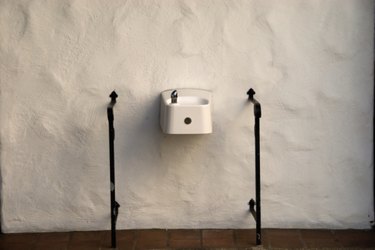Things You'll Need
Wheelbarrow
Masonry sand
Portland cement
Window screen
Spade
18-lb. bag lightweight setting-type 90 joint compound
Drywall bucket
Electric drill
Paddle bit drill attachment
Measuring cup
Putty knife
Dropcloths
Spray bottle
Trowel
Sponge
Smaller trowel

Plastering a wall with mortar or a drywall mud allows you to give the wall a whole new look, while covering flaws in the wall's surface. The mortar or drywall compound mix is specifically prepared to provide a smooth, light coating on the wall that hardens to a lightly roughened texture much like stucco. Once applied, the plaster lasts for years, with proper maintenance to prevent cracking or chipping of the plaster surface.
Step 1
Pour 70 lbs. of masonry sand and half of an 80-lb. bag of Portland cement into a wheelbarrow. Sift any rough material from the sand before pouring into the wheelbarrow using a screen placed over the wheelbarrow. Push the sand through the screen to sift out any gravel. Fold the two materials together with a spade until thoroughly mixed. Add water to the mixture a small amount of time, folding the water in until you have a mortar that barely holds its shape when cut through with the blade of the spade.
Video of the Day
Step 2
Use a drywall mud mix instead of the mortar mix as your plaster, if desired. Mix the mud by filling a drywall bucket with about 4 inches of water. Dump the bag of joint compound into the water and mix thoroughly with an electric drill with paddle bit attachment until the mix is too thick to continue. Turn off the drill and add 1 cup of water. Incorporate the new water into the mix by moving the paddle up and down in the bucket to spread the water through all compound layers. Scrape the mix off the edges of the bucket with a putty knife. Mix again with the paddle. Continue mixing and adding water 1 cup at a time until the mix is the consistency of peanut butter.
Step 3
Place dropcloths onto the ground at the base of the wall to prevent drips from staining the floor. Fill a spray bottle with water, and mist the surface of the wall with the water to prevent the wall from leeching moisture from the plaster when applied.
Step 4
Spread the first coat of mortar or drywall mud onto the wall using a wet trowel blade in a heavy layer. Begin the plastering at a corner or edge of the wall and work your way across the surface to the opposite edge or corner, spreading the mix with the bottom of the trowel. Apply the plaster using an arcing motion, long enough to empty the mortar you can carry on the back of the trowel. Overlap the arcs as you apply the plaster to gain complete coverage of the wall surface. Clear away excess mortar with a damp sponge.
Step 5
Spray the surface of the plaster you've already applied to prevent it from drying out before applying the second coat if needed.
Step 6
Apply the second coat of plaster using a thinner layer. The second coat is the smoothed finish coat of plaster. Place the plaster over the first coat, filling any voids in the first coat while using the same arcing motions. Go over the plaster surface with a slightly damp sponge to smooth it on the wall.
Step 7
Remove the dropcloth and, using a smaller trowel, apply plaster to the base of the wall, immediately removing any that drips on the floor with the damp sponge. Allow the plaster to dry completely before touching the wall.
Tip
Color the plaster before application by adding a concrete colorant while mixing.
Video of the Day